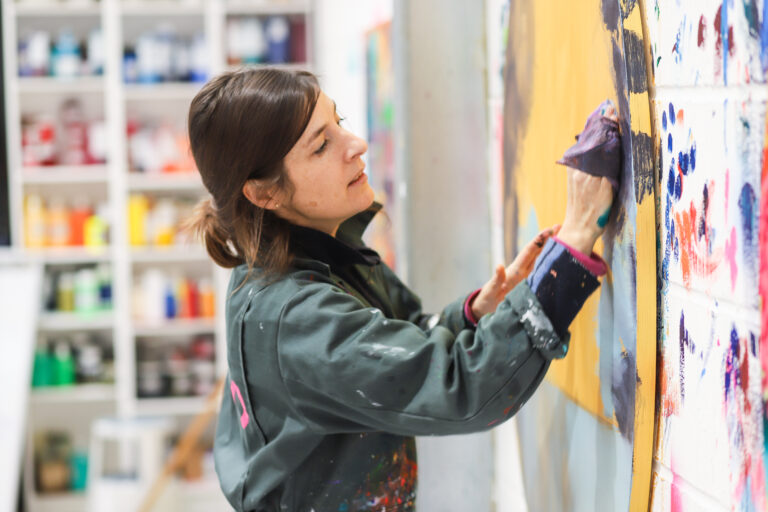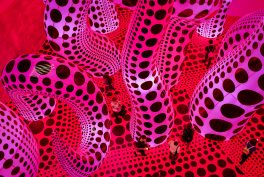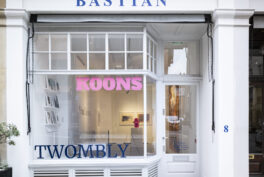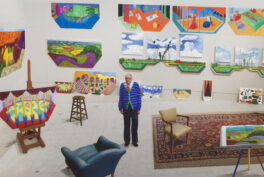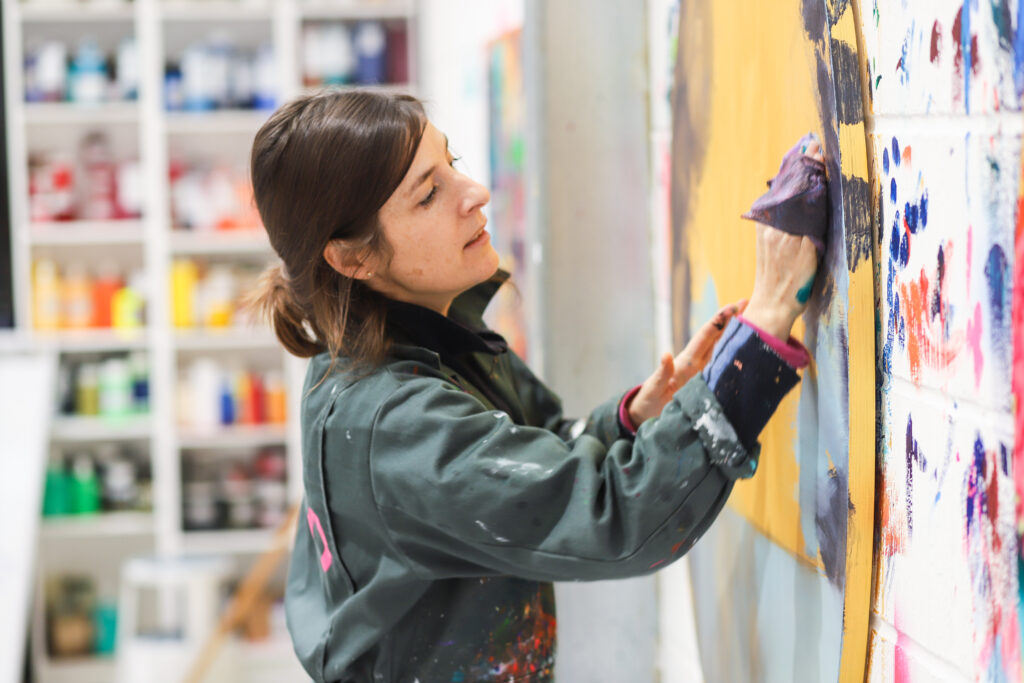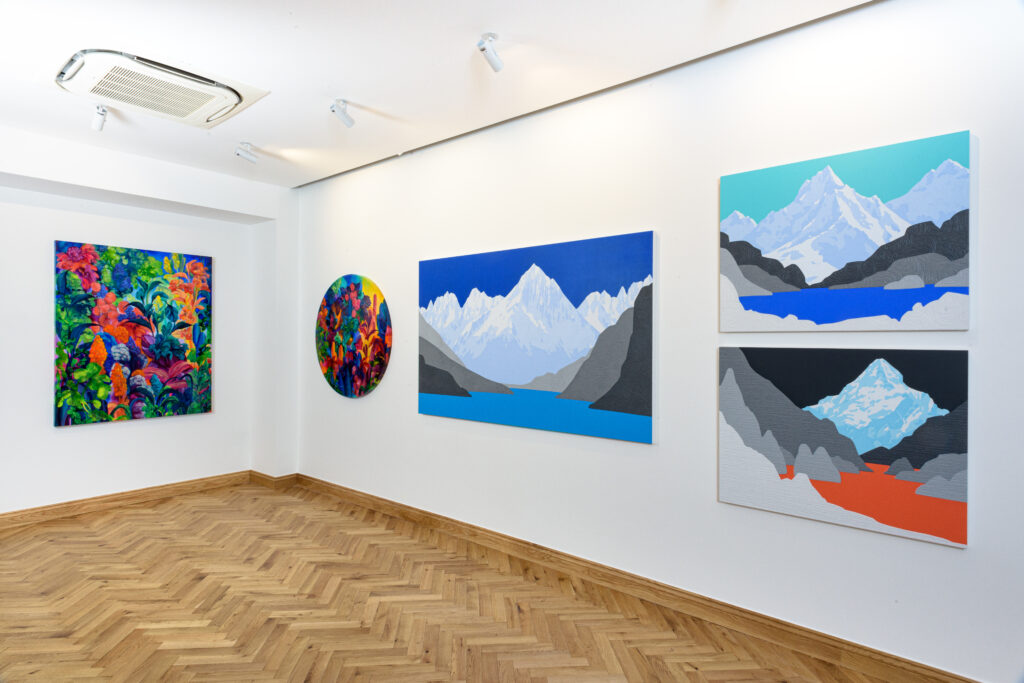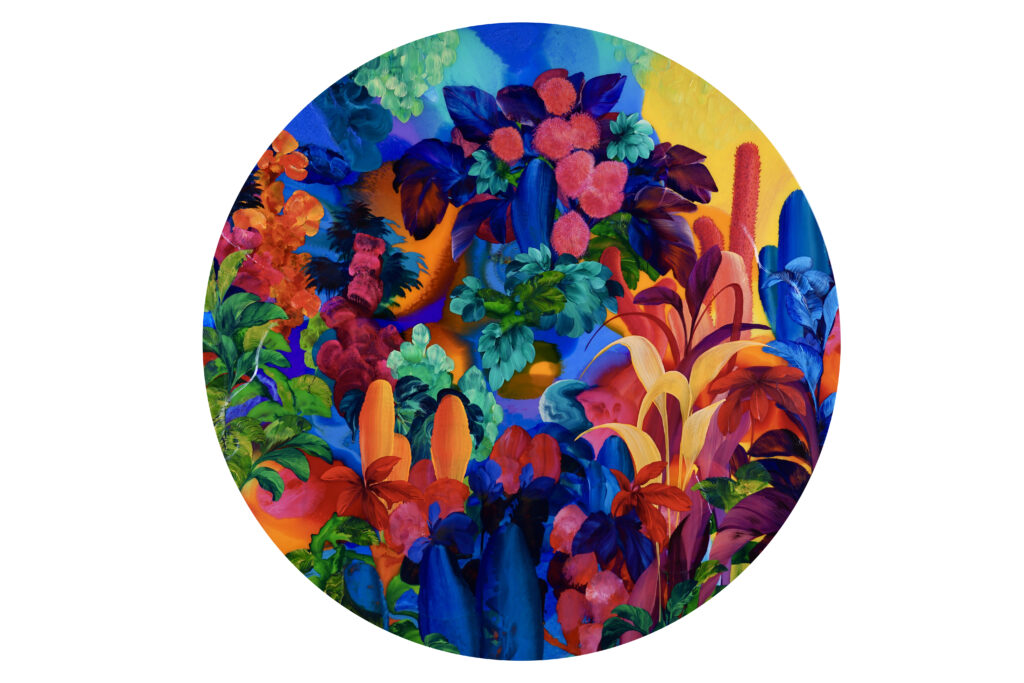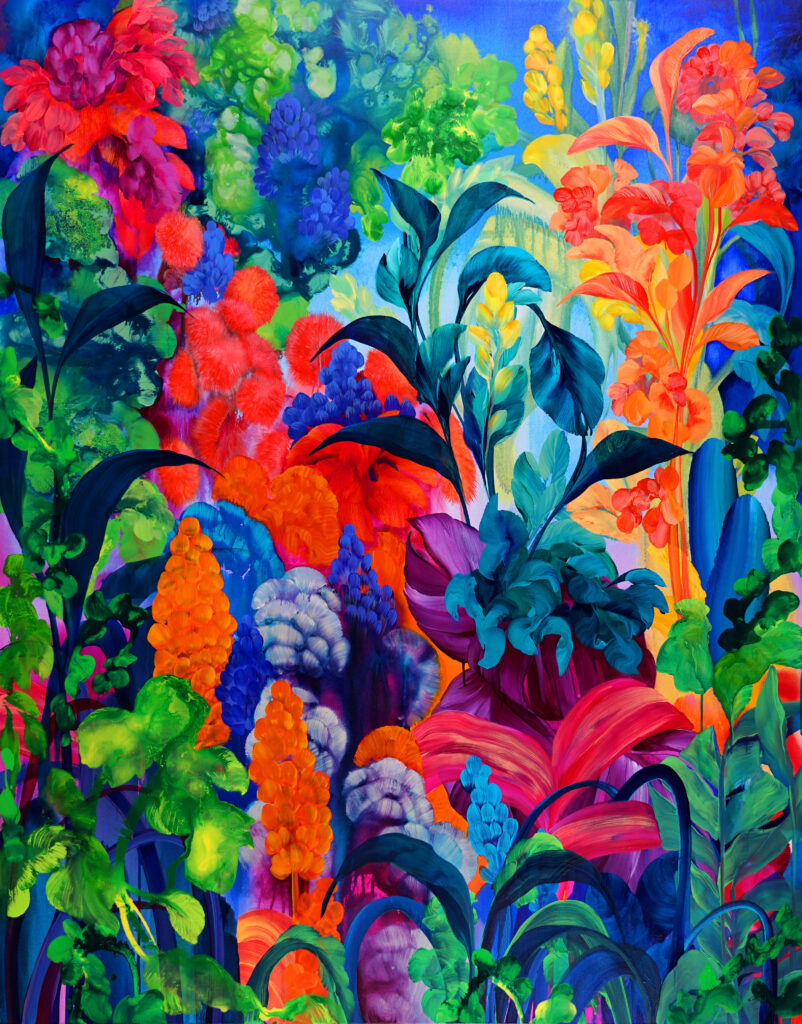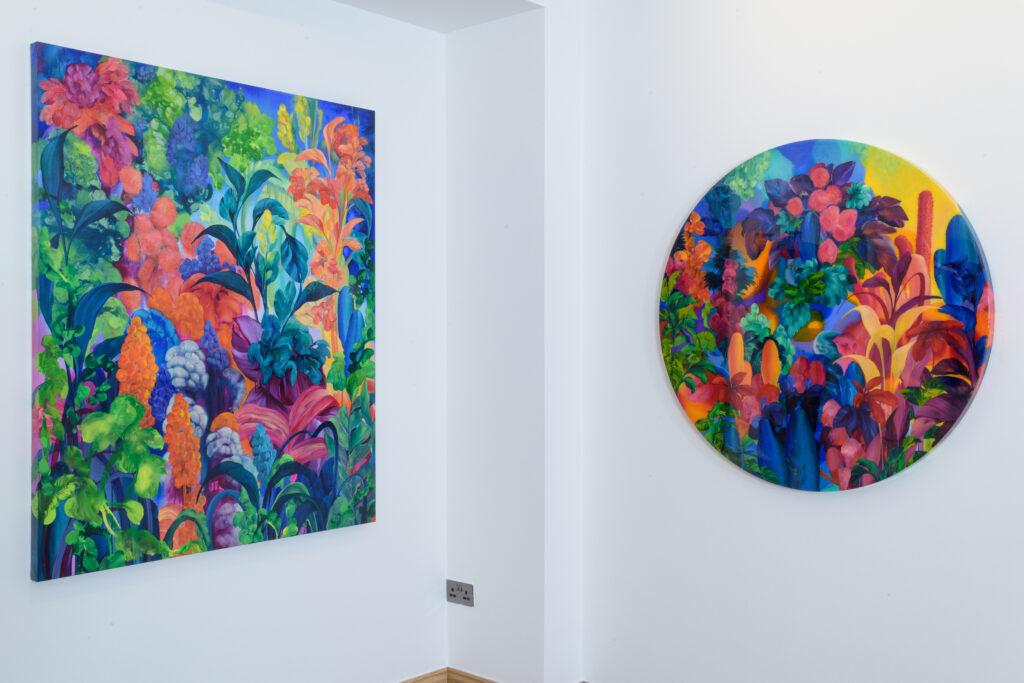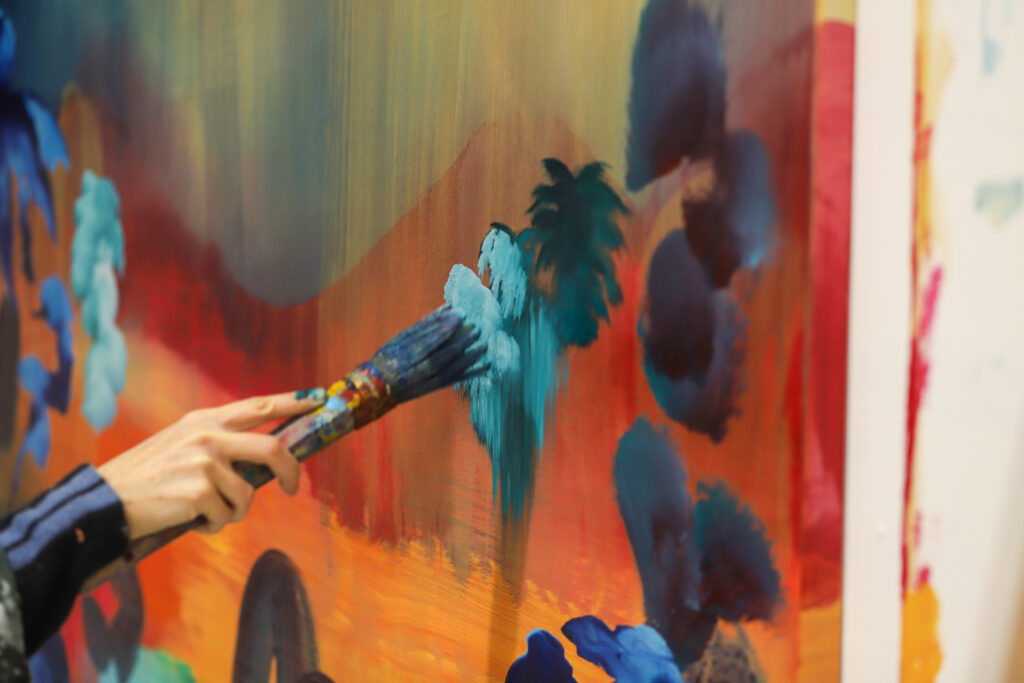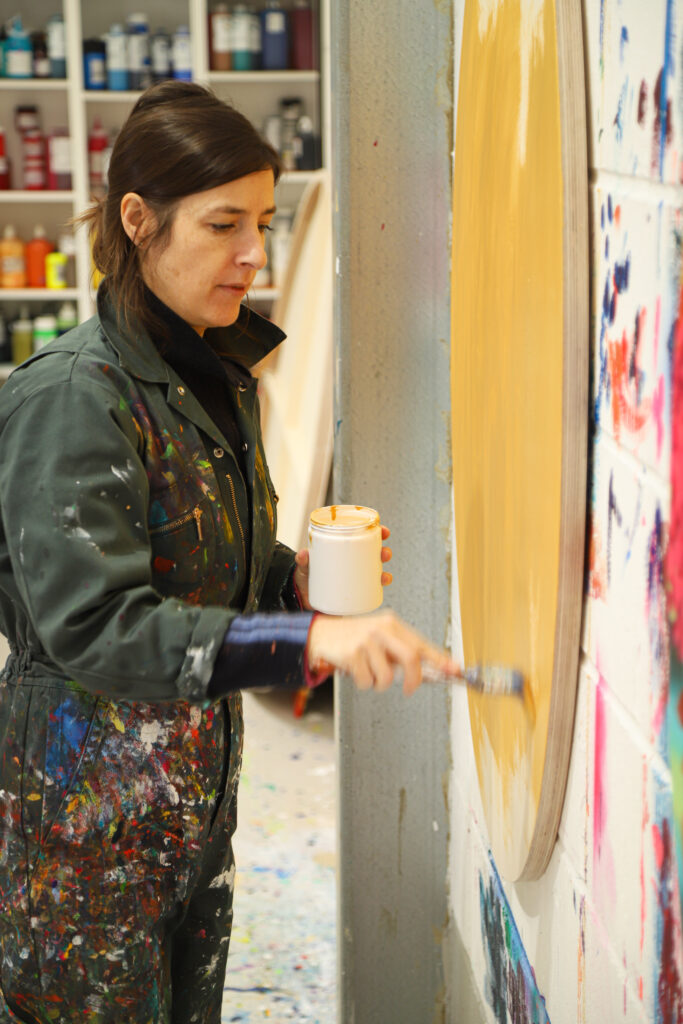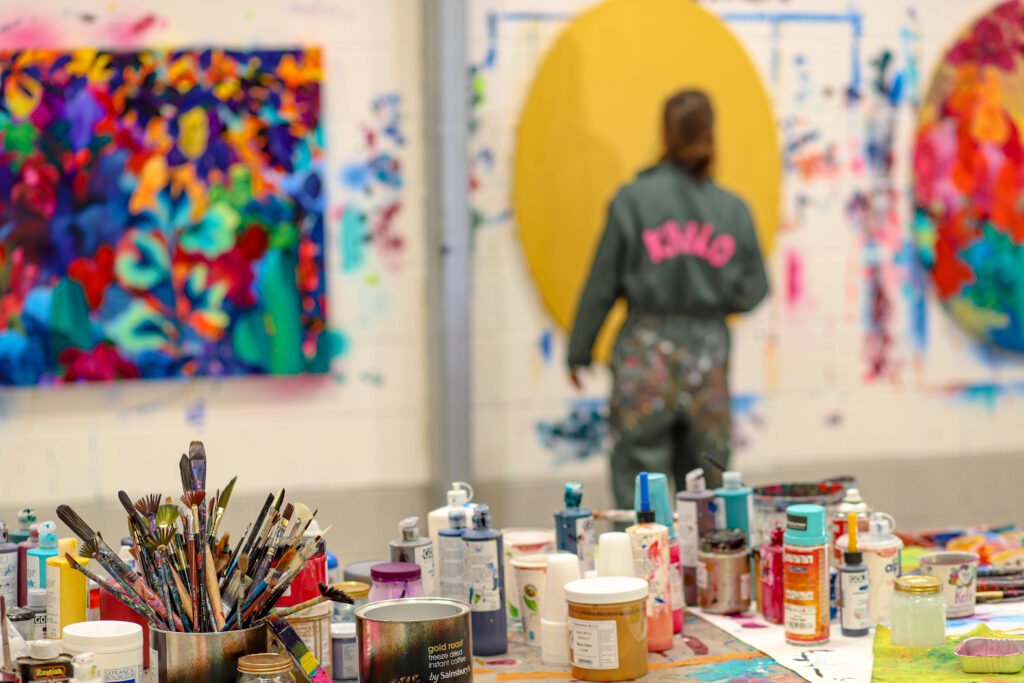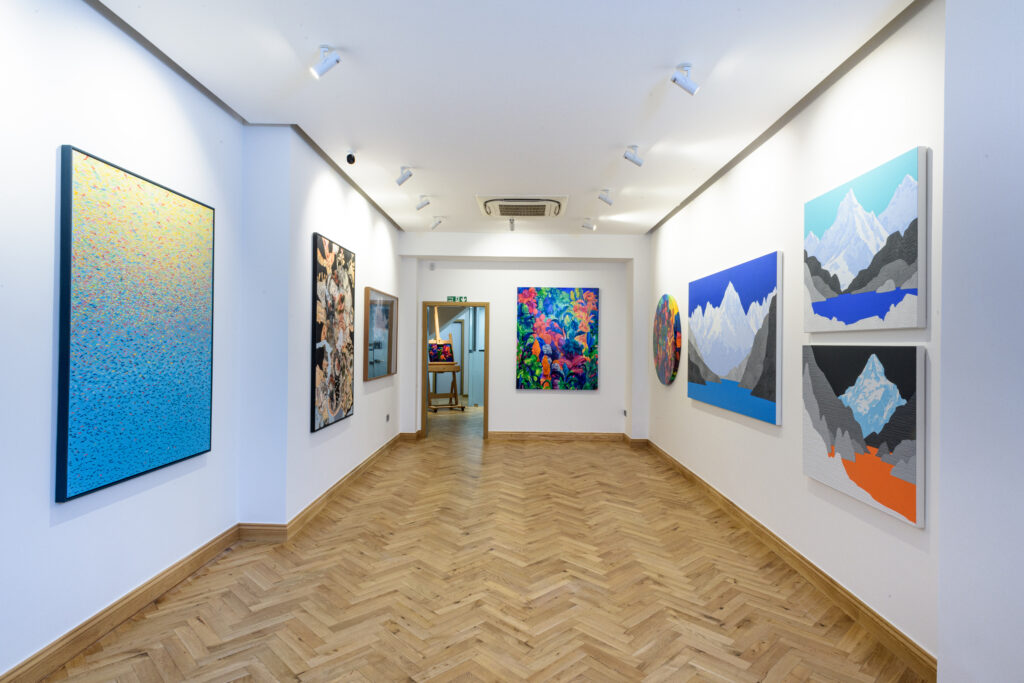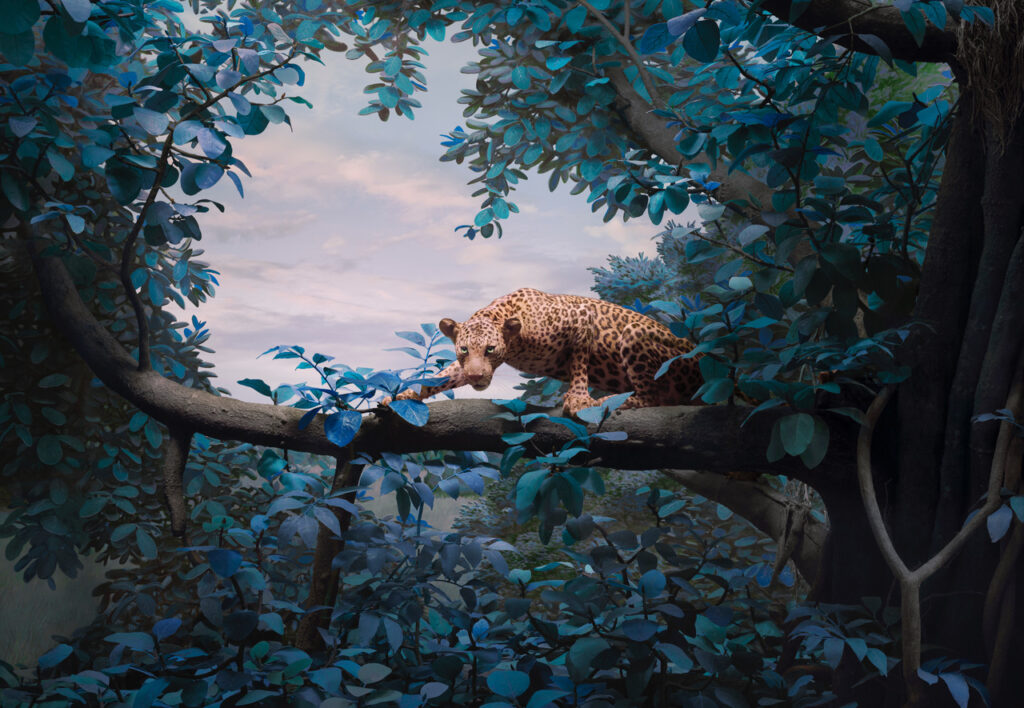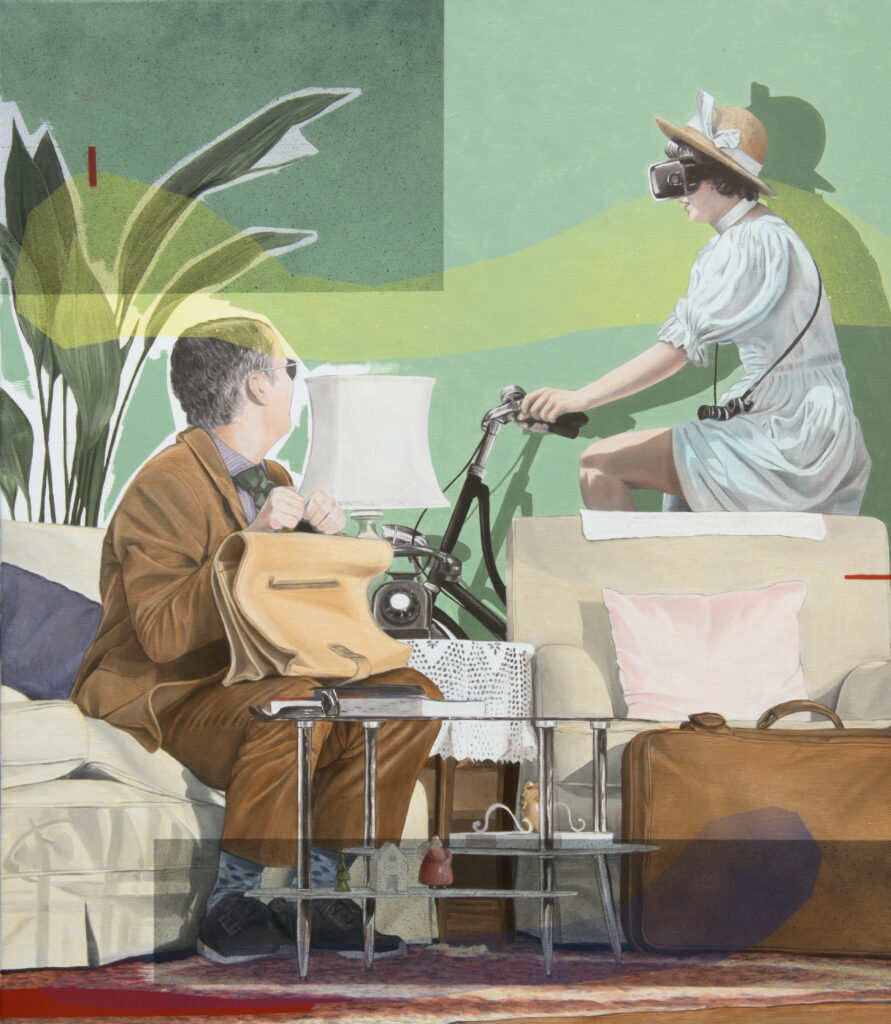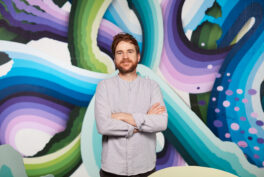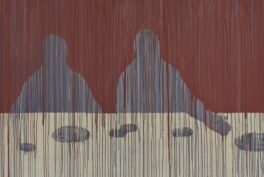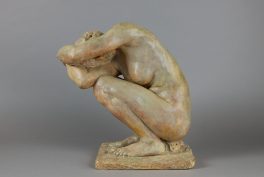The past couple of years, struck by the unfortunate global pandemic, have been a challenging journey for all of us. What may go unnoticed is how they have shaped and completely transformed our understanding of our surroundings. The latest exhibition from Grove Square Galleries, Arcadia, showcases humanity’s relationship with the natural world through a selection of paintings, photographs, and multi-media works created by contemporary artists.
Orlanda Broom is a British artist based in Hampshire. Hauntingly beautiful and fully enigmatic, her paintings hide a darker (and certainly surprising) truth about humanity’s future on this planet. She depicts wild, imaginative places completely uninhabited. Her work is currently featured in Arcadia.
Art in the World of Arcadia
RR: How would you describe your art to someone who has never seen it before?
OB: I paint lush, colorful paintings. I call them landscapes, but they are super dense and floral, almost semi-abstract, so they’re not traditional landscapes in any sense. They’re jungley and quite layered, loosely referencing plants that you would recognize as cactuses, certain types of flowers, and cheese plants. My paintings make botanical references, but they’re not strictly scientific in terms of botanical art – they are made-up plants, so I can borrow elements from all over. I like mixing up cactuses with much more luscious plants that you wouldn’t necessarily find together. They make for slightly strange, surreal places that you kind of have an innate understanding of as being something exotic and luscious.
RR: How do you think humanity’s relationship with nature has evolved over time?
OB: In terms of my work, I have always had this idea that my paintings don’t have any evidence of humans in them. You might question it. What is this habitat? Why isn’t there any evidence of human habitation or animals? There are only plants. This idea of wilderness got a stronghold as the theme in my work. You can’t ignore everything happening at the moment with climate change and think about our impact on the planet. I suppose it’s a weird dichotomy of being positive in one way; this idea of rewilding, the regrowth and reset of the planet, which at some point will be so obliterated and damaged. From a human perspective, of course, that’s quite dark; that’s what I mean, it’s a weird negative yet positive.
RR: Are humans part of this future you envisioned?
OB: No, they’re not there. It’s bleak in our own terms. Like Chernobyl, where the birds have come back, and the plants have grown, and it’s so haunting and ghostly. I see that there’s something so positive about that – plants regrowing. That’s what my paintings have taken to an extreme.
RR: Would you like to talk about your artworks in Arcadia?
OB: Tipping Point speaks about the idea that we are on the verge of something. I tried to have extreme colors in that painting: quite icy blue tones with much hotter colors, which create an imbalance that doesn’t make sense. Pleasure Dome references Kubla Khan by Coleridge, a Romantic poet I think Pleasure Dome has that lightness that I needed, being this joyous painting, whereas Tipping Point may point to this idea of that if you landed in this painting, if you found yourself in this wild place, it might be intimidating in some way, making you feel a bit entrapped. I have to say that I’m happy to talk about my work but I also like it to be quite open to interpretation. I love it when people see different things, analyze them, or read them in a completely different way from how I might be thinking or talking about them. I try to be open and leave some ambiguity around my paintings. The landscapes I’m depicting are timeless in a way. Is this place in the future, or is it way back in the past before humans were around?
RR: How do you come up with the titles for your paintings?
OB: It can be tricky sometimes. I always think of the title once I finish the painting. Sometimes it just pops into my head on that ongoing theme of things I’ve been looking into, or it might reference particular flowers. I try not to tie it down too much to something. I like it to be a bit ambiguous, not giving too much of my own narrative through words on a painting. The title usually references something that has been on my mind. I’ve had quite a few paintings related to Coleridge, such as Pleasure Dome. There was also another painting called Susquehanna Dreamer – without being too literal about it, not too obvious – because Coleridge wanted to set up a colony in Susquehanna. Pleasure Dome is equally from there. However, Tipping Point relates to climate change, being more obvious here.
RR: Do you think the narrative is important in your work?
OB: The way I work is quite intuitive. There is a theme that runs throughout all of my work. When it comes to individual pieces, I just start, and certain elements come through, becoming a bit more defined towards the final stages of the painting. It’s more thematic, generally speaking, in terms of the body of work.
RR: What message are you trying to send to your audience through your art?
OB: I think that’s tricky. I create work for myself most of the time; I’m exploring my thoughts about this idea that we will be wiped out, but the planet will survive. On some level, it’s all about communication. Of course, I want to reach people. What I try to do with my work is entice people with this luscious, beautiful, colorful, bright imagery. I like the idea of creating eye candy that draws people in. Some people see the dark side, while some people think my paintings are just lovely; those views are of equal value, in my opinion. Because art is so individual, my message is a bit ambiguous too. I suppose I paint for myself, and then I hope my work is engaging and communicative. In terms of trying to send a message out, I would resist that slightly.
RR: Has your art style evolved over time?
OB: I’ve always been interested in color. That’s been a constant. When I finished my MA, I was doing photography and installations, and I wasn’t painting at all. There have been many shifts and changes in my work, but I would say that in the last 15 years – when I became a full-time working artist – there’s been a definite change. My paintings are much denser now, although they were probably looser at the start. Today they are more controlled. I think you’d recognize my work. It’s quite different, but the interest in mark-making has been constant.
Traveling around the World and Art during Lockdown
RR: Are there any artists, movements, or places that inspire you?
OB: In terms of places, I’ve traveled quite a bit in the past. I’ve been to places like Thailand and India. I also spent a lot of time in Tobago, where I used to go every year. I’ve been lucky because I traveled quite a bit in the 90s when it was easier. Not anymore, you can’t just go traveling anymore, can you? Looking back, that idea of places being much more intense and the feeling of beauty is heightened… like rose-tinted spectacles when your memories have a golden glow to them. There’s an element of this that I’m trying to put into my paintings. It’s this idealized version of something, like highly saturated colors. I have my memory of places I’ve visited and, of course, I also take references from botanical art. I take many photographs when I travel or visit botanical places such as gardens. I used to live next to one in London, so I went there every week; I could sketch cactuses and all sorts of plants. I’m always feeding my bank of inspiration in this way. And in terms of artists, I often reference Henri Rousseau because his jungle paintings are so dense, having this layered quality, which I tried to do in my work too. I also love all kinds of colorists: David Hockney, Peter Doig. Claire Woods is a contemporary figurative and landscape painter, and I absolutely love her work as well.
RR: Did your travels impact your art?
OB: Definitely. But also what’s interesting is not being able to travel. Like I was saying, especially if you live in a city, a lot of it is in your imagination. I don’t live in London anymore. Now I live in the countryside, but there’s always that hankering for the other. That need for experience and difference and going to different places is always there no matter how much traveling you do; for some, not everyone.
RR: Has the lockdown affected you as an artist?
OB: There are two things. I carried on with work in my studio because I didn’t have any contact with anyone. It was like life was normal for me, which was strange in itself. I also felt incredibly lucky because I was living out in the country, so it was quite a different experience to living in the city. And I also had this real spur to work: I’m always working hard, but it was more important to make really good use of my time. Secondly, the other effect that lockdown had was that I subconsciously wanted to seek more light and positivity in my work, whereas before I had edged towards a slightly darker interpretation. The work I produced through lockdown was for my exhibition at Grove Square Galleries, Rewild. I needed some levity in my paintings, so I was going for more colorful and brighter. They became a bit more joyful, weirdly, given what was happening elsewhere. The work that I was doing before that was touching on quite dark themes, dystopian ideas of post-apocalyptic landscapes, where there aren’t any traces of humans or any habitats, which is still true of my work, but there was a darker element to it. I wanted to let light into my work. It wasn’t conscious; it just happened.
OB: Being an artist is a pretty solitary thing, so it can be that I don’t see anyone for days and days. It’s lovely to have Stinky, my dog, as company at the studio. It gets me out… I have to walk her so I’m in nature every day. My studio is in an industrial estate in the middle of woodlands, so I notice the seasonal changes, walking the same track every day. That feeds into my work. She’s a lovely little thing, Stinky.
Orlanda Broom’s Creative Process
RR: It seems like colors are central to your art and creative process. How do you choose your color palette for each painting?
OB: I use color intuitively. Perhaps it’s useful to tell you how I work on landscapes. I go for it with the initial blank canvas and get down lots of paint, just making lots of marks: throw paint on and make puddles and splash marks. Then I try to preserve some of that dynamic and chance element while editing some bits. I get the density in layering up by working on things, trying to preserve a little splash – it keeps the painting fresh and still has this ordered composition. I’m led by that. I need to be working with the right colors that are going to show off the initial bit from the painting. It needs to be organic and intuitive, but I have my favorite colors, like magenta. I have to tell myself sometimes: ‘No, not more magenta. Leave it alone!’ That’s the thing: having a little bit of restraint there as well. Those fluorescent colors are not found in nature, particularly. They give the paintings a slightly surreal edge, almost like toxicity, especially when I’m using fluorescents or iridescent colors. Sometimes, I use glitters, which are hard to see from the photographs. They are strange and not naturalistic.
RR: The average viewer might say you use unique, unusual painting techniques (acrylic on linen, acrylic and resin on aluminum). Can you explain why you choose those techniques?
OB: What’s important to me is always being fresh with work. When you start a painting, it is experimental, and to keep that dynamic, that playfulness going, you have to use different materials. I’m always trying out different surfaces and mediums and using things like resin. All of those little details change the way that I paint. Aluminum surfaces are amazing; I can get brilliant mark-making on aluminum because it’s like painting on a super glossy hard surface, so I can push the brush around or manipulate the painting in that way. At the same time, the canvas is more absorbent, so I’m not going to be able to get that dark definition of marks. I play with different materials for my interest. Being curious, I suppose. All surfaces have different benefits. I would say to any young artist to try various surfaces because it makes a massive difference. I work mostly on canvas and linen, but it depends on the scale as well. Aluminum is easier to use on a small scale, likewise wood. For larger projects, the canvas is the way to go.
OB: I started out using resin just as a final finish, but I realized over the years that resin is a nice material to use in paintings. You can sort of push what you are doing in terms of art materials. Things might crack or be a bit watery, but because I am sealing things in resin there isn’t the same concern about its durability. So I can be experimental. Physically, resin adds approximately a millimeter of surface, so when you build it up you can actually see shadows underneath the painted layers. It has this slightly 3D quality that encases it, almost becoming an object. But I don’t like to use resin on everything. It’s what takes my fancy at the time.
OB: I’ve got different zones in my studio: I can photograph and resin work; I’ve got my messy area. And in terms of my time, I don’t have to clear things away when I want to do something, say with resin.
RR: Do you enjoy experimenting with different shapes or scales for your paintings?
OB: Working with different shapes is again part of changing it up a little. Composition wise circles can be tricky, and it’s an absolute dream to work on large-scale projects, and it doesn’t come along very often because that has to be commissioned. It’s just not practical to make paintings that large. But that painting I did for the Four Seasons Hotel in Manhattan was just brilliant. Four meters square! It was very intense. I rented an industrial unit away from where I was living. That sort of work was unique in terms of practicality. Long days, seven days a week, and everything else put on the back burner. It was lovely to be painting because my life as an artist is not only about that. The whole thing was amazing!
A Few Final Thoughts…
RR: What’s the best thing about being an artist?
OB: I’m lucky to do something that I love. I appreciate that I have found what I love doing, even though it has been a long struggle to carry on. You have to give up a lot, especially when you’re younger, to get to a point where it’s feasible to be an artist. It’s just fantastic to be autonomous, do my own thing, and be creative, being able to do what I love; because so many people don’t get this chance. It does feel like a privilege to be able to do that.
RR: Do you have any advice for aspiring artists?
OB: For a young artist, it’s important to have a good group of other artists around because you can have each other’s back. It can be quite isolating to be an artist. Also, because it keeps you engaged, it’s always good to be talking about art and practically swapping notes with artists. Secondly, engagement with the art world is also crucial, such as seeing the gallery exhibitions. Keep the faith. I struggled for quite a long time when I started and it just felt impossible. For a long time, I did have to take some time out… I was working in a shop, and, especially being in London, I could not afford a studio. However, I moved to Portugal, and I got a job teaching English. I could rent a studio very cheaply, and I had the whole day to go to the studio because I was teaching in the early morning and evening. It was just a shift in my life that enabled me to kick start what I wanted to do.
RR: Are there any exciting upcoming projects that you are currently working on?
OB: I’m looking forward to doing an exhibition next year with Grove Square Galleries. They’ve been brilliant. I would describe myself as self-representative for a long time, where I would exhibit with other galleries on the invitation, but it has been nice to work with Grove Square lately. It’s just nice to have a show to work towards, really, and to work towards a deadline. I’m mainly focusing on producing some new work for that.
Arcadia is a group show; other artists include Crystal Fischetti, Elena Gual, Christopher Kieling, Jim Naughten, Harry Rudham, Marc Standing, and David Wightman.
From unrealistic plants to fantastic animals, Naughten’s evocative photographs imagine a surreal universe inhabited by unusual creatures, whereas Kieling’s futurist and technological paintings draw inspiration from works of Escher and Uglow, placing man at the center of the universe.
